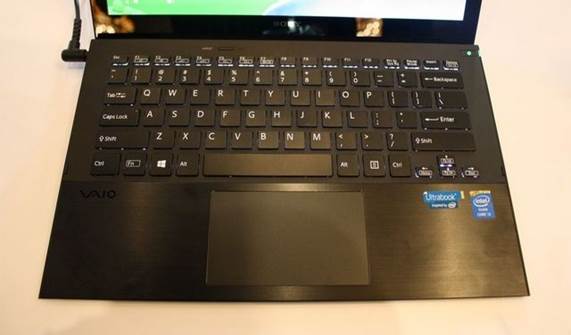Keyboard and trackpad
Sony said that Sony’s island-style keyboard
provides more mobility than on the Z series that was discontinued, which is
indeed quite flat. (At that time, we recognized that typing on it was like
walking in flip-flops. You may have taken notice that we have a similar thing
here). In any case, this new keyboard actually feels more comfortable than the
keyboard we tested two years ago, but there was much room for improvement. All
in all, the difference with Z proves to be remarkable, but if you are coming from
any other ultraportable, it may resemble another shallow Ultrabook keyboard.

Keyboard
and trackpad
If there is something wrong, that's the Pro
11’s small size means that the individual buttons are small, even for the small
hands like yours. We’d hate to say, but typing on them feels like a backlash
about netbooks, with the cramped layouts and the fragile base panels.
(Seriously speaking, get ready to see the keyboard bend, especially if you have
fast typing speed). To be fair, not any netbook we ever tested had the
backlighting keyboard. In addition, Sony made sure that all of the important
keys (Enter, Backspace, etc.) were widely sized, though the letter keys had to
be made small. Consequently, while it is not the most comfortable keyboard
we've ever used, you were able to do much worse, especially if this will be the
travel computer rather than the daily one. Although we have not spent a great
deal of time with the Pro 13, we believe that the cramping is not an issue
there.
After testing the Samsung ATIV Book 7, we
had some belief in Windows trackpads: obviously, it is likely to create one
trackpad that everything works as it should, without any hiccups yet. But let's
go back to the Pro 11: the cursor does not always go where you want it to go,
especially in the desktop mode. Like other trackpads we tested, it does a
better job when it comes to multi-point gestures such as pinch-to-zoom and
two-finger scrolling, both of them have the same sense of controlled motions
and do not require you to use to much force. However, it can make the
pinch-to-zoom gesture and end up doing a side scroll, so you should be careful.
The machine also did not always respond to
the double-taps when we tried utilizing that gesture to open the desktop
applications. Instead, we had to use double-clicking the touch button, but it's
so hard that we did not really want to press it. Hopefully, Sony will solve the
driver problems when this thing goes on sale, although it is too late to handle
the shallow-touch button.

Sony
said that Sony’s island-style keyboard provides more mobility than on the Z
series that was discontinued, which is indeed quite flat.
Screen
At some point - we're not sure when - Sony
had the bright idea is to make many of its parts talk to one another. This
meant that some PSP games that can be played on its Android tablets, and
placing point-and-shot quality cameras into its cell phones. And in this case,
it meant using some of the similar imaging technologies that Sony initially
developed for the Bravia television lines. This consists of a screen with
Triluminos backlighting coming with the mobile version of the X-Reality
processing engine, which you are likely to find inside the Xperia phones
selected.
It looks very nice. The 1,080p resolution
makes everything look fresh, but still easy to watch. Thanks to the IPS
technology, the already-bright colors continue to look nice even when you push
the screen forward or start watching from the side. Although the smooth surface
reflects some light, it has never hampered the reading experience. You are able
to enable or disable the X-Reality engine manually, and it really switches off
automatically by default when you unplug the computer, so these great pictures
will never have to pay the price for the battery life.

It
looks very nice. The 1,080p resolution makes everything look fresh, but still
easy to watch.
All of Sony’s new laptops feature CMOS
Exmor-R webcams, among which low-light imaging technology is thanks to Sony's
imaging unit. As you can see in the sample image below, the low-light images do
not avoid noise, but they are certainly brighter than normal. Surely you are
unlikely to know, but the author took this photo with the lights off and at
dusk when the sun had set.
If Sony cut elsewhere in the Pro 11, it was
the sound quality. The sound is not terrible to listen to - it's really quite
interesting - but the volume is weak. Even at the maximum volume, it was unable
to maintain its position in a quiet room with an open window and a few cars
that are running by outside. So, let’s imagine how it will do this summer, with
that the creaking air conditioners and whirring fans keep going on in the
background. Clearly, weak volume was to be anticipated, and it's not even a big
issue. Just ensure that you make those conference calls in a quiet room (no
window).